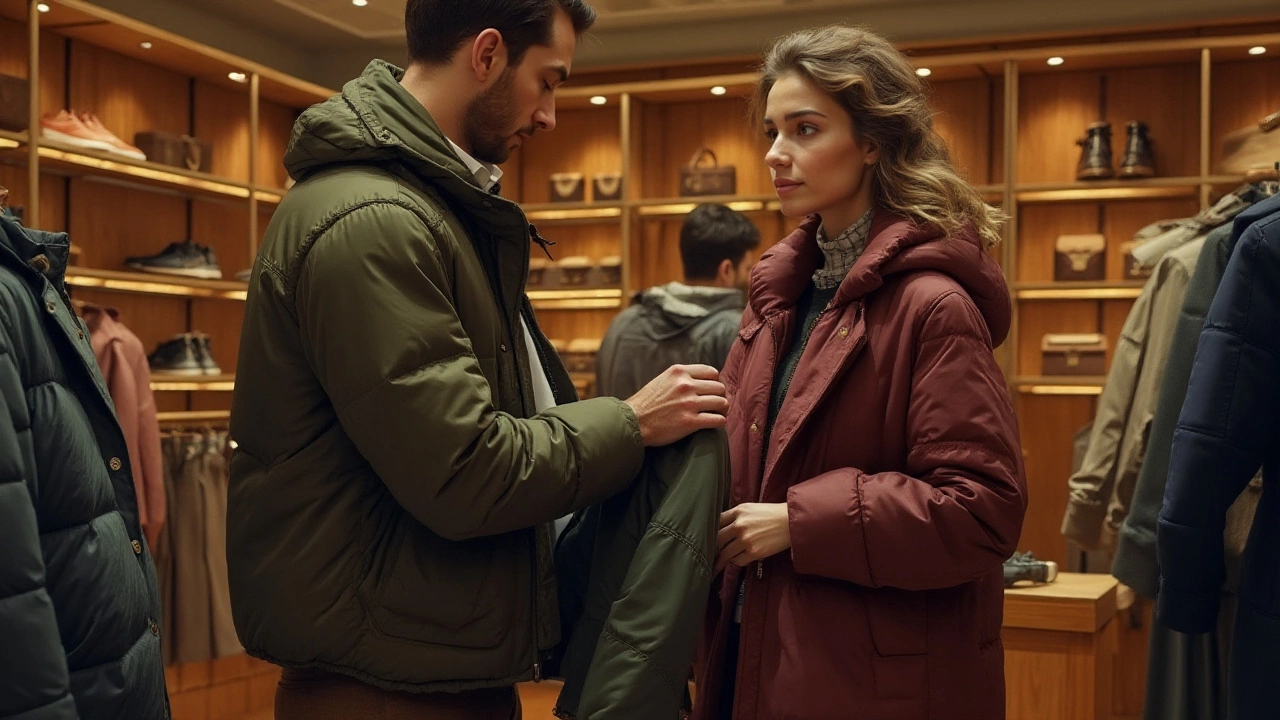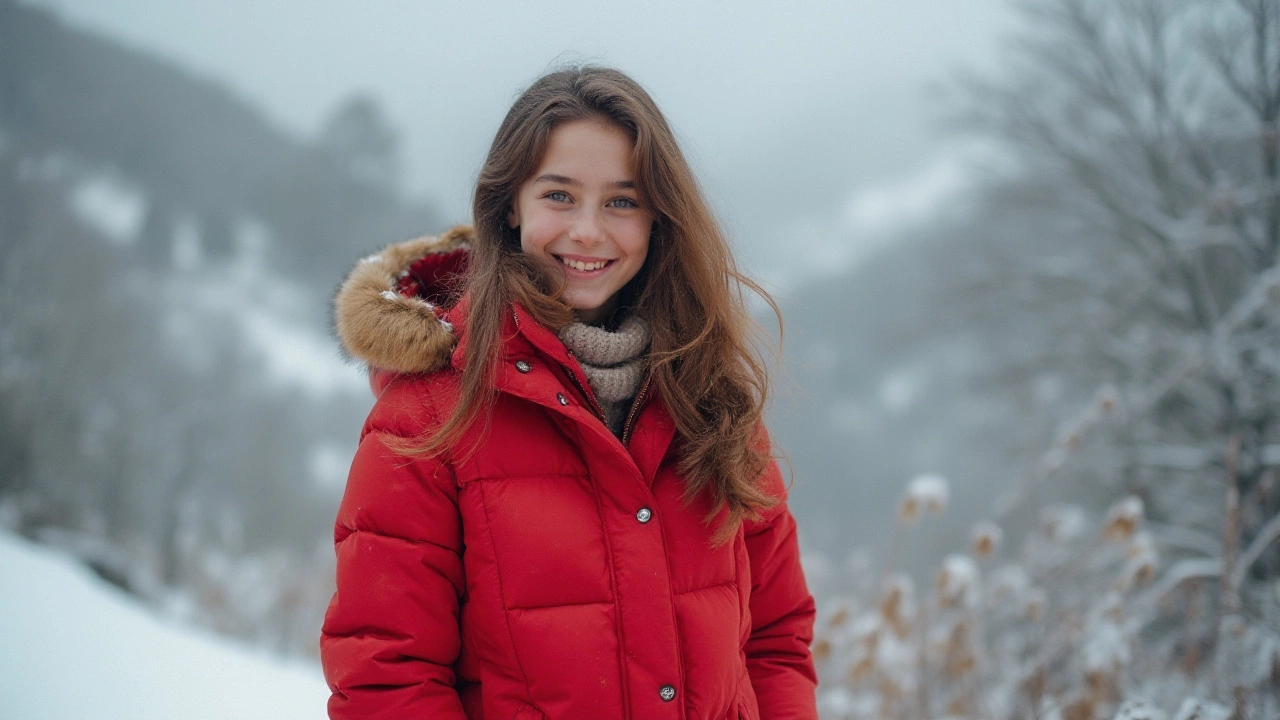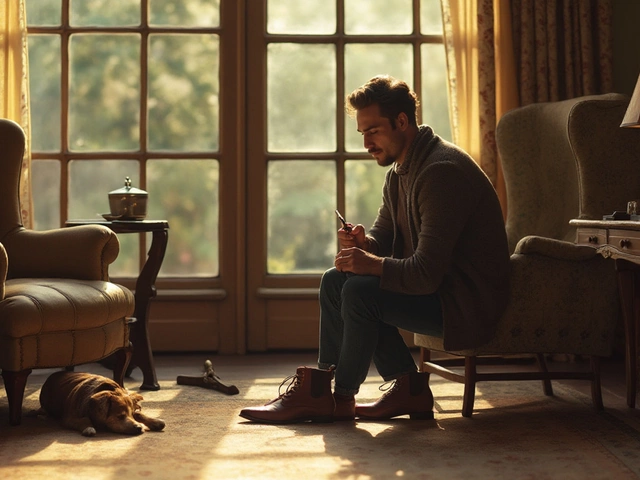Choosing the right fit for a down jacket isn't always straightforward, and different factors come into play when making this decision. Do you prioritize warmth or comfort, or maybe both? The answer could influence whether you opt for a snug or a looser style. Each choice offers its benefits and drawbacks, and understanding these can make your decision easier.
Let's dive into the nitty-gritty of down jackets and explore what makes them such a staple in cold weather attire. Equipped with the right information, you can enjoy the perfect balance of warmth, style, and functionality in your down jacket.
- Understanding Down Jacket Insulation
- Importance of Fit in Retaining Warmth
- Comfort and Mobility Considerations
- Style and Layering Tips
- Practical Guidelines for Choosing the Right Fit
Understanding Down Jacket Insulation
When it comes to staying warm during those chilly months, understanding the insulation within a down jacket is key. Down jackets are valued for their lightweight warmth, achieved through the use of duck or goose plumage. These feather clusters create loft, trapping warmth within countless tiny air pockets. This natural insulation is not only remarkably warm but also incredibly lightweight, making it a popular choice for outdoor enthusiasts and city dwellers alike.
The quality of down is often measured using fill power. This term refers to the number of cubic inches one ounce of down occupies when allowed to reach its maximum loft. Higher fill power indicates more warmth with less weight, as this down will trap more air. Common fill powers range from 450 to 900, with higher numbers indicating better insulating ability. A higher fill power jacket will keep you toasty without the bulk, making it ideal for packing when space is tight.
Alongside fill power, the amount of down used in the jacket, often listed as fill weight, plays a crucial role in warmth. Even with high fill power, a jacket with minimal down may not provide the warmth required for harsh conditions. Balancing fill power with appropriate fill weight ensures that the jacket meets the specific needs—whether you're braving a brisk urban commute or embarking on a snowy mountain adventure.
Down jackets are also generally categorized by their baffle construction, which can impact how well they retain warmth. Sewn-through construction is more cost-effective and common in lightweight jackets, but it doesn't seal in warmth as effectively as baffled construction, which uses additional fabric panels to create the chambers housing the down. This method also minimizes cold spots, making baffled jackets an excellent choice for extreme conditions.
Interestingly, modern technology has given rise to innovations that enhance traditional down jacket insulation. For instance, hydrophobic treated down offers better resistance to moisture, a notable advancement since down can lose its insulating power when wet. As the legendary outdoorsman John Muir once said,
"Keep close to Nature's heart... and break clear away, once in a while, and climb a mountain or spend a week in the woods. Wash your spirit clean."With advancements like these, modern adventurers can heed Muir's call, armed with reliable protection against the elements.
To help you choose the perfect down jacket, consider your typical use case. If you often find yourself in wet conditions, you might prioritize treated down or a jacket with a water-resistant shell. Those planning to wear the jacket in variable climates might balance between higher fill power and multi-layer construction for versatile warmth. Understanding these components of down jacket insulation will help you stay comfortably warm, no matter where your adventures take you.
Importance of Fit in Retaining Warmth
When discussing the warmth of a down jacket, the fit is crucial. A jacket that's too tight can restrict movement and compress the down, reducing its ability to trap heat. This phenomenon happens because down works by creating air pockets that insulate against the cold, and compression diminishes this insulating effect. Conversely, a jacket that is too loose may allow cold air to seep in, reducing the effectiveness of the insulation. Therefore, finding the right balance in your jacket fit is essential for retaining warmth.
Many outdoor enthusiasts argue that a snug fit is ideal for activities in cold weather. A well-fitted jacket ensures that the insulation stays close to your body, maximizing heat retention. The late renowned adventurer Sir Ranulph Fiennes emphasized this, stating, "It's the snugness that keeps the cold at bay; you won't want a deep freeze sneaking in through any gaps." This encapsulates the necessity of a jacket fit that is both warm and functional.
In these scenarios, it's helpful to consider layering. A fitted down jacket serves well as a mid-layer beneath a waterproof shell. If the jacket is too loose, layering becomes awkward, causing overheating or discomfort. Temperature regulation is vital, especially in varying conditions, making the fit even more important. The ability to layer efficiently allows for adaptability in both mild and harsh weather conditions.
Studies have shown that proper fit can increase heat retention by up to 20%. That's a significant difference, especially when facing harsh cold periods. It is important to remember that everyone’s body is different, so the ideal fit will vary from person to person. Finding what works best for your shape and activity level is paramount to getting the most out of your down jacket's insulating properties.
| Finding the Right Fit | Effect on Warmth |
|---|---|
| Too Tight | Reduces warmth by compressing down |
| Too Loose | Allows cold air to penetrate |
| Perfect Fit | Maximizes heat retention by trapping air |

Comfort and Mobility Considerations
When it comes to choosing a down jacket, the balance between comfort and mobility is critical, especially if you're someone who often finds yourself engaged in outdoor activities or simply moving through your daily routine with gusto. A jacket that feels restrictive can limit your movements, turning outdoor adventures into uncomfortable experiences. A snug-fitting down jacket might trap warmth better and offer a sleek silhouette, yet it can restrict natural movement, especially around the shoulders and arms. Imagine trying to reach for something on a high shelf or making room for yourself on a crowded bus. A jacket that's too tight could make these simple actions unnecessarily difficult.
On the flip side, a looser fit can give your body the freedom it needs. It allows for easy layering underneath without feeling like a stuffed bear. But, it's worth being mindful that if a jacket is too baggy, it might leave pockets for chilly air to sneak in. It's much like putting on a pair of shoes; too small, and your toes are in pain; too big, and you risk stumbling over yourself. Finding the happy medium requires understanding your needs and considering the specific environment where you'll be wearing your down jacket most frequently.
"The right balance of fit can enhance your performance and make activities more enjoyable, whether it's a casual walk in the park or a challenging hike," suggests Nina Straver, a seasoned outdoor apparel designer.For those who partake in vigorous winter sports, the extra flexibility of a loosely fitted jacket can be indispensable. Agile maneuvers, whether on mountainsides or icy trails, demand a garment that can stretch and give without constant tugging or realigning. Interestingly, a 2022 study revealed that 47% of outdoor enthusiasts prefer a slightly looser fit for their jackets, citing increased mobility as their main reason.
While considering the practical aspects of motion, the level of activity you're engaging in also matters. Low exertion activities might suit a snug design, offering insulation when your heart rate remains low. Conversely, high-energy pursuits that generate body heat might pair better with a fit that accommodates breathability. Remember that while manufacturers design down jackets to serve a variety of climates, selecting the one that matches your activity levels ensures satisfaction for seasons to come.
Whether you're layering up for a hike or gearing up for a chilly commute, the jacket fit will dictate your comfort levels significantly throughout the day. It's always a good idea to try on different fits and experiment with what layers harmonize best beneath your jacket. Doing so can help you predict how the jacket will perform during a variety of activities. Practicality combined with your personal style ensures that your chosen down jacket becomes a trusted companion in warmth and comfort.
Style and Layering Tips
When it comes to styling your down jackets, versatility is key. Balancing fashion with functionality can make all the difference in achieving the perfect ensemble. The contrast between a fitted and a loose jacket can significantly alter the dynamic of an outfit. For those cold-weather strolls in the city, a well-fitted jacket paired with slim jeans and chunky boots exudes an urban chic vibe. Alternatively, a looser jacket allows for easy layering, complementing athleisure looks with relaxed jogging pants and sneakers.
Layering is more than just an art form; it's a science. The foundation of effective layering begins with the right base layer, typically something moisture-wicking and slightly snug to keep close to your body warmth. As you move outward, mid-layer options could include hoodies or fleeces, ideal for insulation without bulkiness. The down jacket serves as the outer layer, acting as a shield from wind and wet weather. The scientists agree, stating that more space between layers permits superior air circulation, which is paramount in temperature regulation and humidity control. A jacket that’s too tight might compress your layers, compromising this delicate balance.
To fine-tune your style, pay attention to details like color and texture. Neutral shades such as black, navy, or olive are timeless, matching numerous outfits and occasions. However, don't shy away from bold colors or metallic finishes, especially if you like to stand out in a crowd. Consider technical features as well: pockets with zippers for security and adjustable sleeves for practicality are subtle but essential details. Incorporating these elements takes your jacket fit beyond the purely functional, entering a realm that echoes personal style.
Layering also requires attention to climate and activity. During an active ski trip, a tighter jacket might be more beneficial to prevent fabric flapping against the wind, which can interrupt your balance. Conversely, during lighter activities, such as an outdoor winter market visit, a looser fit with ample room for scarves and snug hats enriches the cozy experience. A leading outdoor gear manufacturer notes that optimizing fit according to activity levels leads not only to increased comfort and performance but also enhances the wearer's enjoyment.
Lastly, consider the practicality of layer access for changing temperatures. Easy on-and-off capabilities are vital, especially when frequent temperature shifts are standard, like moving between the outdoors and heated indoor spaces. No one wants to struggle through undoing stiff zippers or tight cuffs when the aim is comfort. As such, investing in jackets with durable, fluid zippers and adjustable hem cords can make a substantial difference in both efficiency and comfort. With these considerations and style tips in mind, you'll be well-equipped to navigate winter's varying landscapes with flair and effectiveness.

Practical Guidelines for Choosing the Right Fit
When it comes to selecting your ideal down jacket, the decision between a tight or loose fit isn’t just an aesthetic choice. The right fit maximizes comfort, warmth, and the jacket's utility as a protective garment against harsh weather. One of the most crucial aspects to consider is your intended use for the down jacket. Are you planning on wearing it as a standalone piece for a hike in the mountains, or are you layering it with other clothing for an urban outing? For outdoor adventures where mobility and functionality are key, a slightly looser fit is recommended as it allows for better range of movement and additional layering when temperatures drop further.
Consider also the type of insulation the jacket provides. If the down is of high fill power, a tighter fit might be more effective at trapping body heat close to your core. A tighter jacket is less likely to have cold spots, areas where the warmth can escape because the jacket is not snug enough against the body. However, a jacket that is too tight can restrict movement and even make one feel suffocated, which is the last thing you need while enjoying a brisk winter walk or hike. Allowing a small space for layering is often advisable, which adds to the versatility of the jacket.
Style and body shape considerations should not be ignored either, as they can greatly affect how comfortable you feel in your down jacket. Pay attention to how the jacket fits around your shoulders and hips. For a standard fit, the jacket's chest should allow for about 2-3 inches of space, allowing for comfort but not looking oversized. A quick trick is the "hug" test: try crossing your arms around your chest, hugging yourself. If the jacket feels too restrictive, it might be worth trying a size up. Remember, the best description of fit is always a balance between personal taste and practicality.
Careful evaluation of the jacket’s construction is also beneficial. Are there adjustable hems or elastic cuffs? These features can help in fine-tuning the fit, sealing out drafts without necessarily choosing a smaller size. Zippers and seams should not only align perfectly but also offer easy open and close without straining the fabric. Buying from reputable brands known for their down jacket expertise can reassure you of getting well-engineered fits designed with user experience in mind. Some brands offer measurement guidelines that help determine your best fit by comparing the jacket’s dimensions relative to your body measurements. Such details can often be a deciding factor since bespoke tailoring is rarely an option with outerwear.
The Outdoor Foundation emphasizes the importance of fitting for environmental adaptation, stating, "A well-fitted jacket can function like a dynamic second skin, adapting to both your physical activity and environmental conditions."
Ultimately, selecting the right fit is about harmonizing your activity requirements, personal comfort, and style preferences, with an understanding that the relationship between these factors is fluid and subjective. By considering these practical guidelines, your choice of a tight or loose fit will translate into your most reliable ally against winter’s chills, allowing you to enjoy the cold months with warmth and confidence.





